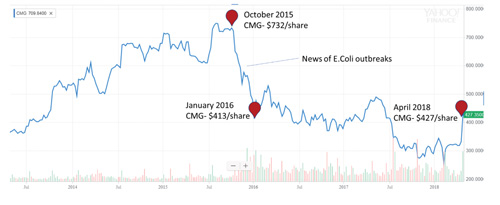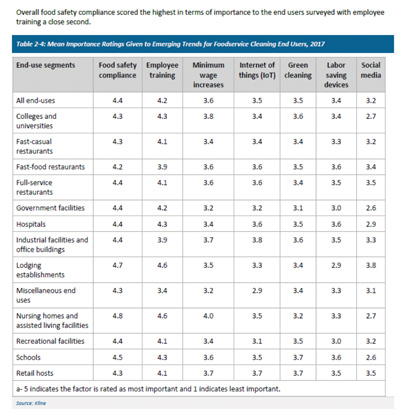— By John Goetz —
Establishing a food safety culture with chemical dispensers.
In a 2017 study published by Kline & Company, food safety compliance in commercial kitchens and food preparation areas was rated as the Number 1 emerging trend by the 750+ end users surveyed.1 Compliance with food safety standards is so important because it can make or break the success of a restaurant.

John Goetz
Take Chipotle’s food safety crisis as an example. In 2015, E. coli and norovirus outbreaks forced some locations to close temporarily after 55 customers fell ill, with the company blaming sick employees for the spread of norovirus.2 In April 2016, the popular restaurant chain reported its first loss since going public in 2006, with transactions falling by more than 20% and stock prices tumbling by as much as 33%.3 At that time, analysts predicted it could take until 2018 for the company to recover from these losses and to date the stock price remains below its highs just before the outbreaks occurred. (See chart via Yahoo Finance.)
 Fortunately, chemical dispensers can help restaurants better comply with various regulations and enhance the food safety culture of a business. It’s important for restaurant managers to understand potential consequences related to lapses in food safety, how dispensers promote compliance, and how to select the right dispensers for their needs.
Fortunately, chemical dispensers can help restaurants better comply with various regulations and enhance the food safety culture of a business. It’s important for restaurant managers to understand potential consequences related to lapses in food safety, how dispensers promote compliance, and how to select the right dispensers for their needs.
The Importance of a Food Safety Culture
Lapses in food safety can result in the following short term consequences:
- Foodborne illnesses that can result in customer complaints and worker absences.
- Costly food safety violations and fines.
- Negative press in the form of news articles and social media backlash that can lead to a loss of patronage.
- Temporary closure that can impact financial stability.
Food safety incidents can also leave a lasting impression on a restaurant’s success. In addition to reduced spending and plunging stock prices, long term fallout can include:
- Potential lawsuits related to foodborne illnesses, hospitalizations and deaths.
- Difficulty retaining talent and attracting new employees.
- Added spending on food safety training to avoid future outbreaks.
- Increased spending on marketing to overcome a damaged reputation and attract once-loyal customers again.
- A permanent shuttering that can affect the financial future of the restaurant group, operators and employees.
Complying with Food Safety Regulations
Chemical dispensers are used in a variety of applications by back-of-house (BOH) restaurant staff and front-of-house (FOH) staff, including:
- Warewashing: Washing dishes at the appropriate temperature, for the right length of time and with the proper amount of cleaning product and mechanical pressure, helps maintain hygiene and control costs. Warewashing can either be completed manually in a three-compartment sink or with help from a dish machine. The Food and Drug Administration’s (FDA) 2017 Food Code lists numerous requirements for warewashing machines, such as being equipped with temperature monitoring devices and a visual means to verify that detergents and sanitizers are delivered or an alarm to indicate if they are not delivered.
 Dispensing systems can give restaurants greater peace of mind around dishwashing. Dispensers can be hooked up to an automatic dishwashing machine to measure rinse water and/or wash tank temperatures. These units can measure and control the concentration of detergent in the wash tank to ensure optimal cleaning. Dispensers can even provide alerts to restaurant staff to change out the dirty wash tank water, stop a wash cycle when no chemical is present in the dishwasher or de-lime the machine to maintain consistent cleaning results and avoid costly issues in the future.
Dispensing systems can give restaurants greater peace of mind around dishwashing. Dispensers can be hooked up to an automatic dishwashing machine to measure rinse water and/or wash tank temperatures. These units can measure and control the concentration of detergent in the wash tank to ensure optimal cleaning. Dispensers can even provide alerts to restaurant staff to change out the dirty wash tank water, stop a wash cycle when no chemical is present in the dishwasher or de-lime the machine to maintain consistent cleaning results and avoid costly issues in the future.
In addition to working alongside warewashing machines, dispensers can also distribute the proper amount of detergents and sanitizer into three-compartment sinks to eliminate dilution guesswork for employees.
- Drain cleaning: Grease traps are installed to capture cooking grease, oils and fats that run off from sinks, dishwashers and floor drains. If not cleaned consistently, this can lead to unpleasant odors and be a breeding ground for biofilms and flies.
Grease traps should be cleaned when 25% of the liquid level of the trap is grease or oil — at least once a month for point-of-use traps and quarterly for in-ground grease interceptors. Regular and proper cleaning of kitchen exhaust hoods and grease traps helps restaurants maintain compliance with the National Fire Protection Association 96 Standard and local or state environmental regulations that may exist around outdoor grease contamination.4
Dispensers easily clean dirty drains and grease traps by moving liquid enzymes or probiotic products through quickly and effectively to break down build-ups. This helps prevent the occurrence of backups and the undesirable side effects, such as odors, maintenance costs and biofilms.
- FOH cleaning: Areas that are visible to patrons, such as counter service areas, dining areas and restrooms, need to be clean to impress guests and reduce the spread of germs that can negatively impact food safety. Food safety regulations will differ by state, but it is important for restaurants to clean food establishments as often as necessary, and during periods when the least amount of food will be exposed.5 Following busy dining hours, tables and other high-touch surfaces should be wiped down; floors should be cleaned and dried; and restrooms should be tended to so that cleanliness is maintained.
When cleaning, the right dilution of chemical-to-water ratio is crucial. Too little and surfaces won’t be effectively cleaned. Too much can leave residues behind or damage certain surfaces. Thankfully, with the adoption of chemical dispensers, employees no longer have to worry about properly mixing cleaning chemicals. Dispensers allow employees to easily and accurately fill spray bottles and buckets for cleaning tasks such as wiping surfaces and mopping spills. Dispensers conveniently fill up all types of containers with accurate dilutions while monitoring water pressure and water levels.
Selecting a Dispensing System
When selecting dispensers for a restaurant, there are several tips to keep in mind.
- Selection: First consider the number of chemical products required for the task at hand and select a unit that can accommodate these. Look for units that use technology to support predictive maintenance, provide remote monitoring, conduct automated adjustments and capture data on key performance indicators.
- Installation: Make sure the system is easy to install and will not require significant lifetime cost to maintain. Systems should be installed in an easily accessible area where water is readily available. Pre-wired electronic dispensers speed up installation times, and systems that can be programmed and commissioned quickly via software also minimize downtime and accelerate the time to first revenue.
- Regular maintenance: Adhering to a schedule of regular maintenance helps guarantee top system performance and limits the risk of lost productivity and expensive repairs. Filters and strainers should be regularly cleaned to prevent particles from the water line from entering the valve and metering tips should be replaced regularly to ensure accurate dilution ratios. Finally, if peristaltic tubes are being used, replace tubing as it wears down, and remember to check dosing parameters and recalibrate as needed.
Safe and Sound
The presence or absence of a strong food safety culture can dictate the lifespan and overall success of a restaurant, whether it operates a single unit or has hundreds or thousands of locations. Both management and employees need to be on board with food safety efforts and make a commitment to regularly clean key surfaces and areas and stay home when illness strikes. Increasingly, dispensers are being utilized for different tasks within restaurants to maintain compliance with hygiene standards and keep food safety at the forefront. From warewashing to drain cleaning to FOH cleaning, dispensers are multifunctional and invaluable tools for restaurants that prioritize the health of their customers, employees and business.
Sources:
2 https://www.cnbc.com/2016/02/08/chipotle-blames-norovirus-outbreaks-on-sick-employees.html
3 https://www.fool.com/investing/2016/06/22/why-chipotle-stock-is-down-17-in-2016.aspx
4 http://www.epa.ohio.gov/portals/41/sb/publications/restaurant.pdf
5 https://www.fda.gov/Food/GuidanceRegulation/RetailFoodProtection/FoodCode/ucm122814.htm
— John Goetz is a global product manager for Hydro Systems, an independent manufacturer of chemical injecting, proportioning, dispensing and medicating equipment. For more information, visit http://hydrosystemsco.com/.
